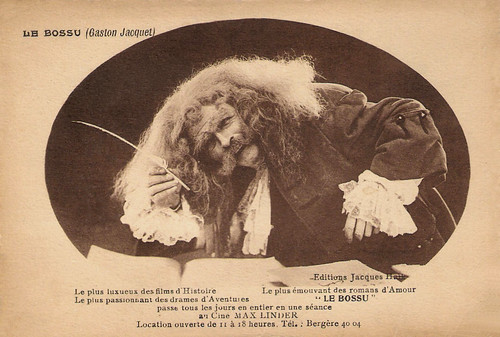
Gaston Jacquet in Le Bossu (1925). French postcard by Films Jacques Haïk. Photo: Combier Mâcon.
Swashbuckler Novel
Paul Féval's historical adventure novel Le Bossu was first published in serial parts in Paris in 1858.
The novel is one of a number of works such as Alexandre Dumas’ The Three Musketeers (1844) which helped define the genre of ‘swashbuckler’ novel, known in French as a ‘roman de cape et d'épée’.
Féval’s son, Paul Féval Fils borrowed his father's hero Chevalier Henri de Lagardère for his own series of Lagardère novels. For the film, he also co-wrote the scenario.
The story deals with the wealthy aristocrat De Lagardère (played by Gaston Jacquet), who wants to avenge the death of his friend the Duc de Nevers (Jean Lorette).
The Duke was killed in a treacherous duel by the Prince of Gonzague (Marcel Vibert) many years ago. The Prince was jealous of the other man's riches, and after killing him, Gonzague also married de Nevers’ widow, Aurore (Claude France).
De Lagardère steals Irène, the child of Nevers and Aurore, and several years after, he returns pretending to be the deformed hunchback of the Rue Quincampoix. He unmasks Gonzague and holds Irène's (Nilda Duplessy) hand in return.
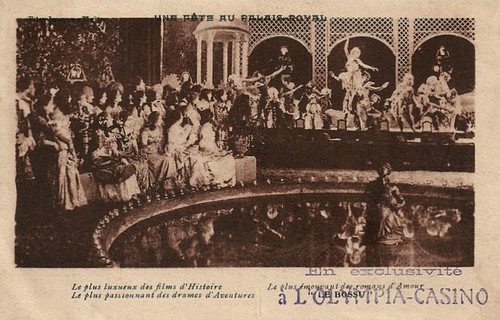
French postcard by Films Jacques Haïk. Photo: Combier Mâcon. Caption: 'Une fête au Palais-Royal'. (A party at the Royal Palace)

Gaston Jacquet as Lagardère and Nilda Duplessy as Irène de Nevers in Le Bossu (1925). French postcard by Films Jacques Haïk, no. 120. Photo: Combier Mâcon.

French postcard by Editions Cinématographiques Jacques Haïk, no. 1. Photo: publicity still for Le Bossu ou le Petit Parisien (Jean Kemm, 1925). Caption: "Une scène dans le salon du regent" (Scene in the Salon of the Regent).
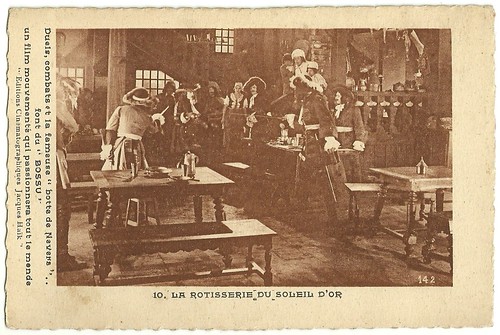
French postcard by Editions Cinématographiques Jacques Haïk, no. 10. Photo: publicity still for Le Bossu ou le Petit Parisien (Jean Kemm, 1925). Caption: "The Rotisserie du Soleil d'Or" (The Grill of the Golden Sun).
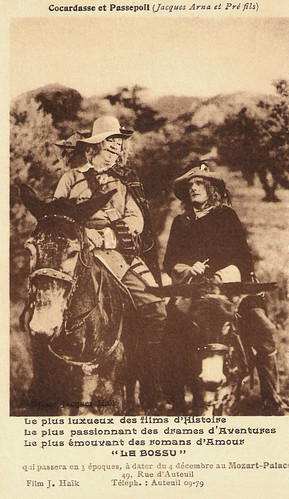
French postcard by Films Jacques Haïk. Photo: Combier Mâcon. Publicity still for Le Bossu ou le Petit Parisien (Jean Kemm, 1925) with Jacques Arna aka Arna and Louis Pré fils as the comic sidekicks Cocardasse and Passepoil. Louis Pré fils (1884-1970) was a French actor, who acted mainly in supporting parts in French cinema, during the 1920s and 1930s. He peaked in the early 1920s in such films als Les trois mousquetaires/The Three Musketeers (Henri Diamant-Berger, 1921), Vingt ans après/Twenty Years Later (Henri Diamant-Berger, 1922) and Le Bossu (1925). Jacques Arna only acted in a handful of French silent films, including Vingt ans après/Twenty Years Later (Henri Diamant-Berger, 1922) , Le Bossu (1925) and La passion de Jeanne d'Arc/The Passion of Joan of Arc (Carl Theodor Dreyer, 1928). Arna was also an historian, a graphologist and an opera singer.
French Resistance
Le Bossu (1925) was probably the first production of French film pioneer Jacques Haïk (1883–1950).
Haïk had been an active French film distributor during the early sound era. He had introduced the Charlie Chaplin films in France and was the inventor of his French name Charlot.
He later created the famous Paris venue Olympia, and built film studios in the Paris suburbs of Courbevoie and La Garenne. He also opened several prestige cinemas in France, including Le Grand Rex (1932) in Paris, the biggest cinema of Europe.
The postcards that were produced to promote Le Bossu show that the film was presented in Haïk's Olympia ('in exclusivity'), but also in the Ciné Max Linder and the Mozart-Palace, both in Paris.
Ciné Max Linder opened in 1912 as Kosmorama. In 1914 actor-director Max Linder bought the cinema and renamed it after himself. Today, the cinema still exists, though it has been completely modernized.
The Mozart-Palace existed between 1913 and 1954. It is now a supermarket.
After Le Bossu, Jacques Haïk would continue to produce dozens of French films until the Second World War.
During the war, the Jewish and anti-Nazi Haïk joined the Forces Françaises Libres (French resistance) and became its representative in the Arab world. After the war he returned to France and tried to recover his property and films that had all been confiscated by the Germans. Five years later he died.

French postcard by Editions Cinématographiques Jacques Haïk, no. 5. Photo: publicity still for Le Bossu ou le Petit Parisien (Jean Kemm, 1925). Caption: "Lagardère {à L'Enfant" ((Young) Lagardère).
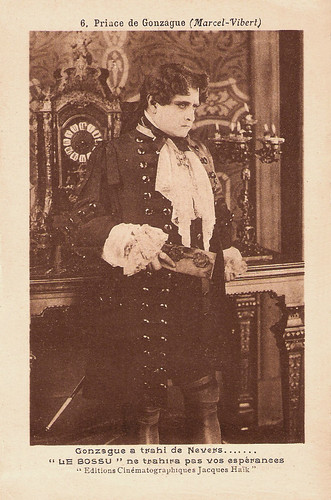
French postcard by Editions Cinématographiques Jacques Haïk, no. 6. Photo: publicity still of Marcel Vibert as the Prince de Gonzague. Caption: 'Gonzague a trahi de Nevers... Le Bossu ne trahira vos espérances'. (Gonzague has betrayed de Nevers, but Le Bossu will not betray your expectations.)
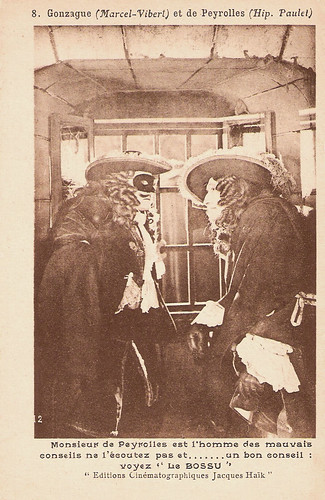
French postcard by Editions Cinématographiques Jacques Haïk, no. 8. Photo: publicity still of Marcel Vibert as the Prince de Gonzague and Hypolyte Paulet as de Peyrolles. Caption: 'Monsieur de Peyrolles est l'homme des mauvais conseils ne l'écoutez pas et ... un bon conseil: voyez Le Bossu'. (Mr. de Peyrolles is the man of bad advice. Don't listen to him and ... a good advice: see Le Bossu.)

French postcard by Editions Cinématographiques Jacques Haïkm no. 9. Le Bossu ou le Petit Parisien (Jean Kemm, 1925) with Maxime Desjardins as Le Régent. Caption: "Le luxe n'est rien sans le goût et la mesure. 'Le Bossu' est monté avec goût et la mesure: voici un film Français." (Luxury is nothing without the taste and measure. Le Bossu is mounted with taste and measurement: this is a French film.)
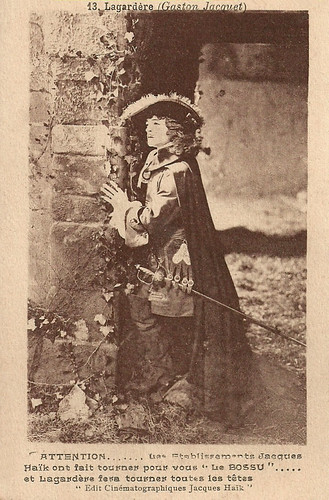
French postcard by Editions Cinématographiques Jacques Haïk, no. 13. Photo: publicity still of Lagardère (Gaston Jacquet). Caption: 'Les Etablissements Jacques Haïk ont fait tourner pour vous Le Bossu... et Lagardère fera tourner toutes les têtes.' (Les Etablissements Jacques Haïk will 'turn' (film) Le Bossu for you... and Lagardère will turn everybody's head.)
Film Versions
Le Bossu/The Hunchback (1925) was not the first screen adaptation of Féval’s adventure novel, and not the last. The novel was filmed more than 10 times.
The original film version was the silent short Le Bossu (André Heuzé, 1912) starring Henry Krauss and Yvette Andréyor.
Krauss repeated his interpretation in Le Bossu (1923) opposite Claude Mérelle and Edouard de Max. Ten years after the original silent version, René Sti made the first sound version Le Bossu (1935) with Robert Vidalin as Henri de Lagardère, Josseline Gaël as Aurore de Caylus and Samson Fainsilber as Monsieur de Peyrolles.
In 1943 followed a Mexican version El jorobado (Jaime Salvador, 1943) and a year later a new French version Le Bossu (Jean Delannoy, 1944) starring Pierre Blanchard as Henri de Lagardère.
In 1955 came another Latin-American version, the Argentine production El juramento de Lagardere (León Klimovsky, 1955).
Probably the best known version is Le Bossu (André Hunebelle, 1959) starring Jean Marais and Bourvil.
The mini-series Lagardère (Jean-Pierre Decourt, 1967) featured Jean Piat, Sacha Pitoëff and Jacques Dufilho.
Thirty years later Lagardère returned to the cinema in the lush Le Bossu/On Guard (1997, Philippe de Broca). Among the cast were such French stars as Daniel Auteuil as Lagardère, Fabrice Luchini as Gonzague, and Vincent Perez as De Nevers.
The most recent adaptation was the TV film Lagardère (Henri Helman, 2004) with Bruno Wolkowitch.
Trailer of Le Bossu ( Philippe de Broca, 1997). Source: Cinemaetcie (YouTube).
Sources: Les indépendants du premier siècle (French), Wikipedia and IMDb.
You've peaked my interest. I'll have to look for some version of this story on video.
ReplyDelete